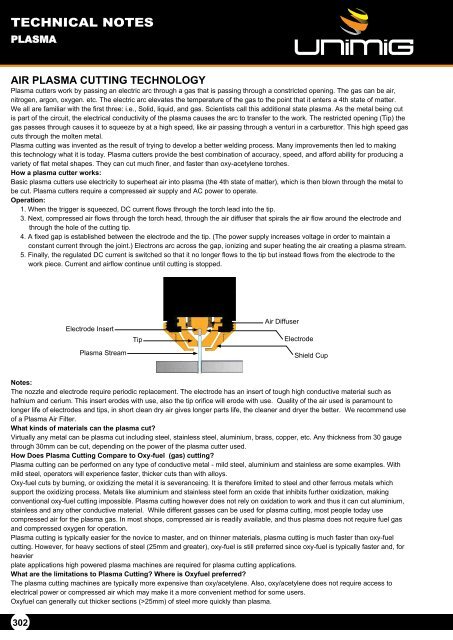Create successful ePaper yourself
Turn your PDF publications into a flip-book with our unique Google optimized e-Paper software.
TECHNICAL NOTES<br />
PLASMA<br />
AIR PLASMA CUTTING TECHNOLOGY<br />
Plasma cutters work by passing an electric arc through a gas that is passing through a constricted opening. The gas can be air, <br />
nitrogen, argon, oxygen. etc. The electric arc elevates the temperature of the gas to the point that it enters a 4th state of matter.<br />
We all are familiar with the first three: i.e., Solid, liquid, and gas. Scientists call this additional state plasma. As the metal being cut<br />
is part of the circuit, the electrical conductivity of the plasma causes the arc to transfer to the work. The <strong>res</strong>tricted opening (Tip) the<br />
gas passes through causes it to squeeze by at a high speed, like air passing through a venturi in a carburettor. This high speed gas<br />
cuts through the molten metal. <br />
Plasma cutting was invented as the <strong>res</strong>ult of trying to develop a better welding process. Many improvements then led to making<br />
this technology what it is today. Plasma cutters provide the best combination of accuracy, speed, and afford ability for producing a<br />
variety of flat metal shapes. They can cut much finer, and faster than oxy-acetylene torches.<br />
How a plasma cutter works:<br />
Basic plasma cutters use electricity to superheat air into plasma (the 4th state of matter), which is then b<strong>low</strong>n through the metal to<br />
be cut. Plasma cutters require a comp<strong>res</strong>sed air supply and AC power to operate.<br />
Operation:<br />
1. When the trigger is squeezed, DC current f<strong>low</strong>s through the torch lead into the tip.<br />
3. Next, comp<strong>res</strong>sed air f<strong>low</strong>s through the torch head, through the air diffuser that spirals the air f<strong>low</strong> around the electrode andthrough<br />
the hole of the cutting tip.<br />
4. A fixed gap is established between the electrode and the tip. (The power supply increases voltage in order to maintain a<br />
constant current through the joint.) Electrons arc across the gap, ionizing and super heating the air creating a plasma stream.<br />
5. Finally, the regulated DC current is switched so that it no longer f<strong>low</strong>s to the tip but instead f<strong>low</strong>s from the electrode to thework<br />
piece. Current and airf<strong>low</strong> continue until cutting is stopped.<br />
Electrode Insert<br />
Plasma Stream<br />
Tip<br />
Air Diffuser<br />
Electrode<br />
Shield Cup<br />
Notes:<br />
The nozzle and electrode require periodic replacement. The electrode has an insert of tough high conductive material such as <br />
hafnium and cerium. This insert erodes with use, also the tip orifice will erode with use. Quality of the air used is paramount to<br />
longer life of electrodes and tips, in short clean dry air gives longer parts life, the cleaner and dryer the better. We recommend use<br />
of a Plasma Air Filter.<br />
What kinds of materials can the plasma cut?<br />
Virtually any metal can be plasma cut including steel, stainless steel, aluminium, brass, copper, etc. Any thickness from 30 gauge<br />
through 30mm can be cut, depending on the power of the plasma cutter used.<br />
How Does Plasma Cutting Compare to Oxy-fuel (gas) cutting?<br />
Plasma cutting can be performed on any type of conductive metal - mild steel, aluminium and stainless are some examples. With<br />
mild steel, operators will experience faster, thicker cuts than with alloys.<br />
Oxy-fuel cuts by burning, or oxidizing the metal it is severanceing. It is therefore limited to steel and other ferrous metals which <br />
support the oxidizing process. Metals like aluminium and stainless steel form an oxide that inhibits further oxidization, making <br />
conventional oxy-fuel cutting impossible. Plasma cutting however does not rely on oxidation to work and thus it can cut aluminium,<br />
stainless and any other conductive material. While different gasses can be used for plasma cutting, most people today use <br />
comp<strong>res</strong>sed air for the plasma gas. In most shops, comp<strong>res</strong>sed air is readily available, and thus plasma does not require fuel gas<br />
and comp<strong>res</strong>sed oxygen for operation.<br />
Plasma cutting is typically easier for the novice to master, and on thinner materials, plasma cutting is much faster than oxy-fuel<br />
cutting. However, for heavy sections of steel (25mm and greater), oxy-fuel is still preferred since oxy-fuel is typically faster and, for<br />
heavierplate<br />
applications high powered plasma machines are required for plasma cutting applications.<br />
What are the limitations to Plasma Cutting? Where is Oxyfuel preferred?<br />
The plasma cutting machines are typically more expensive than oxy/acetylene. Also, oxy/acetylene does not require access to <br />
electrical power or comp<strong>res</strong>sed air which may make it a more convenient method for some users. <br />
Oxyfuel can generally cut thicker sections (>25mm) of steel more quickly than plasma.<br />
302


